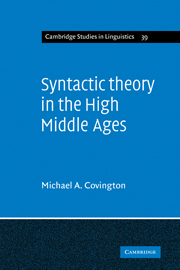Book contents
- Frontmatter
- Contents
- SOLI DEO GLORIA
- Preface
- 1 Introduction
- 2 Before the Modistae
- 3 Modistic grammar
- 4 Syntactic structure
- 5 Modistic treatments of particular syntactic problems
- 6 Subsequent developments
- Appendix: Notes on certain questions of authorship
- Notes
- Bibliography
- Index of names
- Index of topics
- Index of Greek terms
5 - Modistic treatments of particular syntactic problems
Published online by Cambridge University Press: 04 August 2010
- Frontmatter
- Contents
- SOLI DEO GLORIA
- Preface
- 1 Introduction
- 2 Before the Modistae
- 3 Modistic grammar
- 4 Syntactic structure
- 5 Modistic treatments of particular syntactic problems
- 6 Subsequent developments
- Appendix: Notes on certain questions of authorship
- Notes
- Bibliography
- Index of names
- Index of topics
- Index of Greek terms
Summary
The true test of any linguistic theory is, of course, its actual use in the analysis of language. As the Modistae applied their model of sentence structure to the various sentence-types of Latin, they found, naturally enough, that certain structures posed problems, and they argued for or against modifications in the theoretical framework in much the same manner as their present-day counterparts.
Among the important issues in modistic syntax were constituency versus dependency (an issue raised in the analysis of coordinate structures and embedded sentences), grammatical relations in impersonal clauses, and the relation of anaphoric pronouns to their antecedents. In this chapter I shall present samples of the modistic discussion of these issues, drawn mainly from the work of Radulphus Brito. I make no attempt to trace the complete history of each question, but only to give a sampling of the arguments.
Conjunctions and constituent structure
One of the basic presuppositions of modistic syntax is that all grammatical relations link individual words, not groups of words. That is, the modistic model is a dependency grammar, not a constituency grammar – and, like all dependency grammars, it has difficulty dealing with coordinating conjunctions.
Consider, for example, the sentence Socrates et Plato currunt, ‘Socrates and Plato are running’: what is its subject?
- Type
- Chapter
- Information
- Syntactic Theory in the High Middle AgesModistic Models of Sentence Structure, pp. 83 - 119Publisher: Cambridge University PressPrint publication year: 1984



